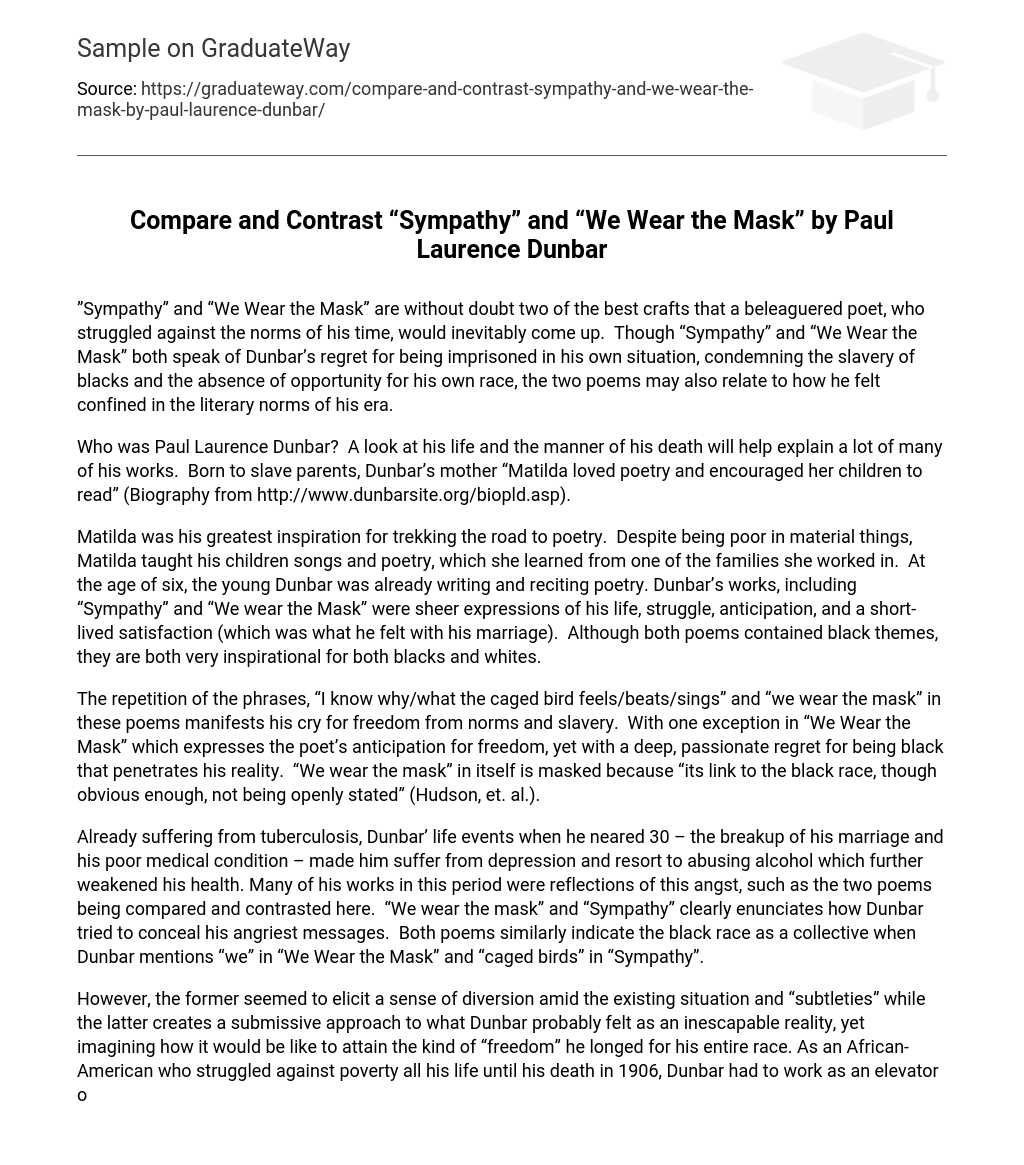”Sympathy” and “We Wear the Mask” are without doubt two of the best crafts that a beleaguered poet, who struggled against the norms of his time, would inevitably come up. Though “Sympathy” and “We Wear the Mask” both speak of Dunbar’s regret for being imprisoned in his own situation, condemning the slavery of blacks and the absence of opportunity for his own race, the two poems may also relate to how he felt confined in the literary norms of his era.
Who was Paul Laurence Dunbar? A look at his life and the manner of his death will help explain a lot of many of his works. Born to slave parents, Dunbar’s mother “Matilda loved poetry and encouraged her children to read” (Biography from http://www.dunbarsite.org/biopld.asp).
Matilda was his greatest inspiration for trekking the road to poetry. Despite being poor in material things, Matilda taught his children songs and poetry, which she learned from one of the families she worked in. At the age of six, the young Dunbar was already writing and reciting poetry. Dunbar’s works, including “Sympathy” and “We wear the Mask” were sheer expressions of his life, struggle, anticipation, and a short-lived satisfaction (which was what he felt with his marriage). Although both poems contained black themes, they are both very inspirational for both blacks and whites.
The repetition of the phrases, “I know why/what the caged bird feels/beats/sings” and “we wear the mask” in these poems manifests his cry for freedom from norms and slavery. With one exception in “We Wear the Mask” which expresses the poet’s anticipation for freedom, yet with a deep, passionate regret for being black that penetrates his reality. “We wear the mask” in itself is masked because “its link to the black race, though obvious enough, not being openly stated” (Hudson, et. al.).
Already suffering from tuberculosis, Dunbar’ life events when he neared 30 – the breakup of his marriage and his poor medical condition – made him suffer from depression and resort to abusing alcohol which further weakened his health. Many of his works in this period were reflections of this angst, such as the two poems being compared and contrasted here. “We wear the mask” and “Sympathy” clearly enunciates how Dunbar tried to conceal his angriest messages. Both poems similarly indicate the black race as a collective when Dunbar mentions “we” in “We Wear the Mask” and “caged birds” in “Sympathy”.
However, the former seemed to elicit a sense of diversion amid the existing situation and “subtleties” while the latter creates a submissive approach to what Dunbar probably felt as an inescapable reality, yet imagining how it would be like to attain the kind of “freedom” he longed for his entire race. As an African-American who struggled against poverty all his life until his death in 1906, Dunbar had to work as an elevator operator even after the publishing of his first book called Oak and Ivy containing his first collection, this, despite a blossoming career as a promising, young writer and a renowned poet. He had to continue this job to pay off his debt with the publishing company that published his first book.
In short, behind the popularity was a poet who’s still imprisoned in poverty and social maxims (that clearly abolished any opportunity for blacks). Even his poetry did not escape the cynicism of critics of his time and until today. But Paul Laurence Dunbar is undoubtedly the most celebrated African-American poet of his age who until today continues to receive acclaim not only for his works but also for his great outlook.
Works Cited
- Hudson, Gossie H. et. al. On “We Wear the Mask.” December 18, 2007. http://www.english.uiuc.edu/maps/poets/a_f/dunbar/mask.htm
- “Biography: The life of Paul Laurence Dunbar”. December 18, 2007. http://www.dunbarsite.org/biopld.asp
- Dunbar, Paul Laurence. “Sympathy.” December 18, 2007. http://www.web-books.com/classics/Poetry/Anthology/Dunbar_PL/Sympathy.htm





